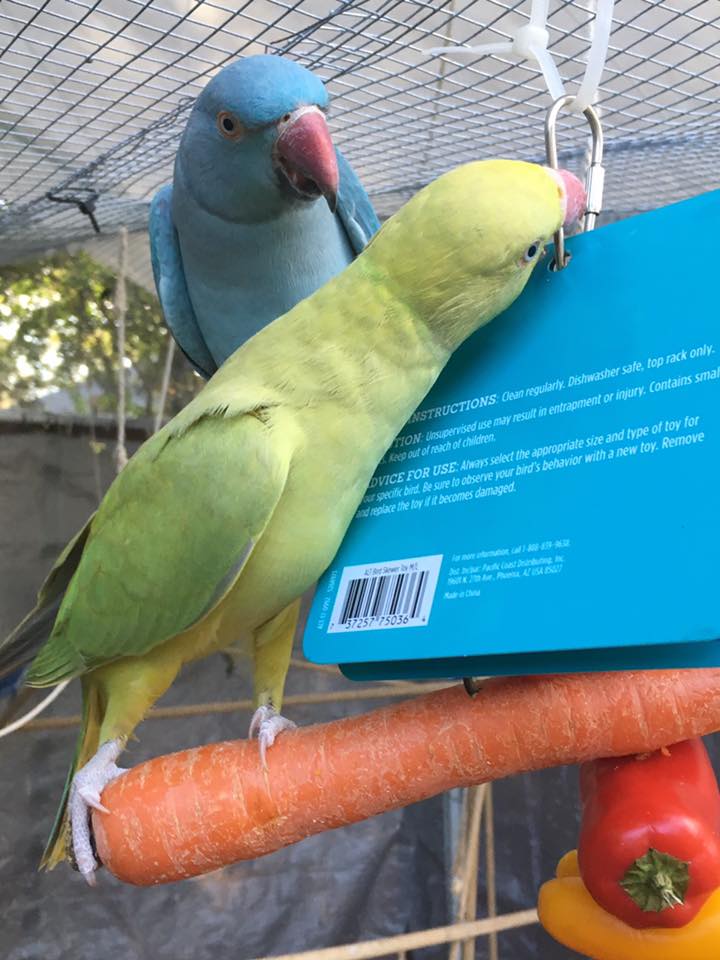One of the most common things we hear from prospective parrot owners is that they have narrowed down their choice of companion down to “A ringneck or a conure.” I always respond by saying “Then you really haven’t narrowed it down at all; those are extremely different birds.” Then I struggle to quantify exactly HOW these birds are different when any “which bird should I buy” quiz you find online will assign them to the same people. After all they need about the same amount of time daily, about the same amount of space, about the same level of dietary prep, about the same size of toys, have about the same volume level, cost about the same, so… aren’t they about the same? No, they are not.
Before I get into the nitty gritty of why a ringneck is nothing like a conure you need to understand that we are speaking in general terms, and there will be exceptions to every rule. Each bird has their own personality and how they are raised will also greatly impact their behavior. The key is to choose the species that is MOST LIKELY to fit in well with your lifestyle, family, and desires. Follow that up with the best care, love, and understanding that you can possibly give that bird, and you are on the road to a happy relationship. So with that in mind, lets explore the differences between most conures and most ringnecks.

Cuddle Factor
This is one of the most striking differences to consider. A simple google image search of “cuddly conure” will show you thousands of images of conures snuggling up to their owners, nestling inside clothing, sleeping on their backs, and just being the absolute picture of warm-fuzzies. Not so ringnecks. Sure, a lot of well raised ringnecks enjoy sitting with their owners and even being stroked and receiving scritches, but in general they are much more hands-off. A hang out pal, not a cuddle buddy. Many ringnecks prefer that their owners never stroke them at all, but only touch their feet. Some allow petting on the beak and head, but others reject even that. Proper socialization from an early age can show your bird that hands aren’t scary, but just because a bird isn’t afraid of being touched doesn’t mean he wants the contact or will allow it. This does not mean ringnecks are not affectionate, just that their affection is shown differently than the average conure. Most ringnecks will be thrilled to sit on your shoulder and gently nibble on your ear, preen your hair, attempt to remove your freckles, groom your eyebrows, inspect your nostrils, give you a manicure, and chat away the whole time. They still want your attention and companionship, they just don’t typically desire or tolerate the puppy-dog style snuggling that conures usually crave.
Fear of Fingers
Join any ringneck group on facebook and you will see dozens of posts about a ringneck absolutely terrified of fingers. For whatever reason, ringnecks seem to be genetically predisposed to lose their minds at the sight of human fingers. Where a conure or cockatiel may be best approached with a finger, a ringneck can be thrown into hysterics by that, and is better approached with a closed fist or at least a flat “plank” hand. In tame birds this is usually temporary and subsides once the bird feels safe around the person, but it is an important thing to realize when getting to know a new bird.
The Wild Ones
This is a controversial topic and many will disagree, but this is what I have observed myself in my own flock as well as in conversations with others who raise and live with ringnecks. Some ringnecks are not meant to be tame pets. The first year that I hand raised ringnecks I did not have any of my own eggs hatch, and I purchased babies from other breeders to raise. I raised seven chicks from three sources; five of the chicks were and still are excellent pets, two weaned themselves early and went completely wild on me. I was stunned and confused, what had I done wrong? Nothing. Since then I have observed that I can usually tell which babies are going to do this within a few days of pulling them for hand feeding. Some pairs produce none of these “born wild” birds, others produce chicks that usually do not make good pets. This is why I counsel people to NEVER buy a ringneck that “used to be tame but needs work.” Usually that really means that the bird weaned and went wild. These birds should be allowed to live happy lives in aviaries, not forced to live in cages and endure human attempts to force a relationship that the bird doesn’t want.
That leads me to a related topic; the ease of taming a bird purchased wild. There ARE people out there who have tamed adult wild ringnecks, but there are very few who feel that those birds fully trust them. Often these birds who have been “tamed” by their new families never move past the very basic stages such as “he doesn’t panic when I feed him.” This species is exceptionally hard to tame as adults when compared with conures, cockatiels, and other similarly sized species.
This is particularly frustrating because for some reason a lot of people are producing ringnecks without bothering to socialize them with humans at all. They then sell these birds “for cheap” to unsuspecting families insisting that with a little work they will have an adorable companion who loves them. This leads to nothing bur suffering for the bird and frustration for the new family.
The Voice
Ringnecks and conures are often listed in the same category as far as noise level, but this is deceptive. I would agree that the volume is similar but the sound is very different. This may not seem like a big deal, but it can be. The grating call of the typical conure differs greatly from the high-pitched squeal of a ringneck. One may be a sound you can deal with, the other may drive you bonkers. Even between ringnecks and lovebirds, another bird with a high pitched clear call, the difference is significant. I can listen to my flock of ringnecks call all day, but put me in the room with a few lovebirds calling back and forth and my stress level begins to rise rapidly. Before you decide on a ringneck it is important to actually hear their call and honestly ask yourself if you want to listen to it for the next 20-30 years. Youtube is a great place to compare the sounds of birds even if it doesn’t give you the experience of the full volume.
The Sheer Energy
No one is going to call conures low-energy as a group, but ringnecks typically take it to the next level. While my conures are sitting calmly on my shoulder, most of the time my ringnecks are still running around searching for mischief to get into. If a bird that is constantly looking for something to get into doesn’t sound fun, a ringneck probably isn’t the best choice for you. Actually, a conure probably isn’t the best option either in that case, but a ringneck even less so.
The Pair Bond
Conures mate for life, ringnecks typically do not. This means that as a general rule ringnecks are less likely to choose one family member and reject all the others. This behavior can of course be managed in conures and other pair-bond species, but in general the ringnecks tend to have an easier time with a family pet dynamic.
Wing Clipping
Wing clipping in general has it’s pros and cons in any situation, but as a rule ringnecks tend to respond poorly to wing clipping when compared to conures and other common companion species. In my experience a temporary clip can be useful in adjusting the attitude of a cranky conure while you work on some foundation training, it often has the opposite affect on ringneck. A sweet and trusting ringneck is more likely to turn defensive and resort to nipping when losing the freedom to fly. This does not mean they should never be clipped, but that if you plan to keep your feathered companion trimmed, a ringneck might not be the ideal choice.
Conclusion
Hopefully these clarifications are helpful to anyone trying to decide which parrot is best suited for their lifestyle but the best advice I can give anyone who is truly interested in making the right choice is this; Spend time in person with ADULT birds of the same gender you are interested in of the species you are considering. Nothing compares to in person experience. Also remember that all babies eventually go through puberty which, like with humans, can be extremely unpleasant and can end with an adult bird whose personality is nothing like the baby you brought home. This is just one of the many reasons to consider adopting an adult bird is an excellent first choice for anyone, but especially for those who are new to the species.


Leave a Reply